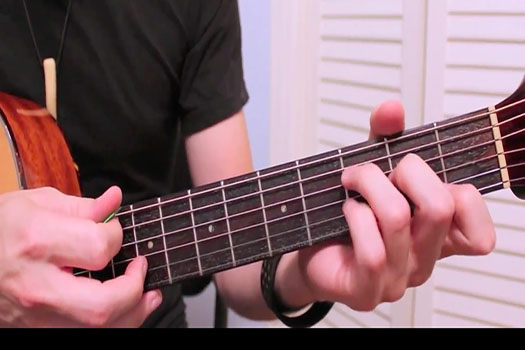Here’s a great solo on a classic standard, often played as a ballad but here as a medium swing. This is the first chorus of Colin’s solo taken from a video of a gig in London from 2010, and what struck me about this chorus is the simplicity of its phrasing. The 32 bars of transcription discussed here exemplifies a well-balanced first chorus of improvising in the jazz/bebop style. Oxley repeats simple melodic and rhythmic motifs over different chords, for example, the triplet idea juxtaposed by an eighth note (from the end of bar 6 to bar 8) moving down the C major scale and then finishing on an F melodic minor/F Dorian sound over the Fminor7 chord.
Throughout his solo, Colin employs an interesting harmonic device—the diminished sound—over cadences. The diminished 7th arpeggio starting from the major 3rd, 5th, 7th, or flat 9th of the V7 chord (for example, B/D/F/Abdim7 over a G7 chord in the key of C) has a striking tension. The release of that tension at the end of the cadence is easy on the ears and simple to understand, because each of the chord tones from the dim7 arpeggio resolve up or down to chord tones in the I chord.
Taking this concept one step beyond the arpeggio, Colin uses the diminished scale—known as the octatonic (8 notes per octave) or the whole half/half whole (referring to the repeating pattern of intervals)—for the same purpose. For example, in bar 11 the harmony is moving from V7 to I in the key of F major. In this bar, Oxley plays straight up the appropriate diminished scale (G, from the 5th of the V chord) and ends neatly on an enclosure (surrounding notes) of the root of the Fmajor chord in bar 12 to resolve the tension. Two other notable examples include the A7-Dm7 cadence in bars 22-23, during which Colin uses a few notes from the Bbdim scale (the flat 9th of the V7 chord) mixed with part of an A7 arpeggio to resolve cleanly to an F in the Dm7 chord, which is the 3rd. He also uses it right at the end of the chorus to cadence into C major in a blistering descending line of 16th notes, starting from F (the 7th of the V7 chord) straight down the diminished scale to land on G (the 5th of C) on a thundering downbeat!
Oxley’s creative use of this scale in terms of not only harmony, as discussed above, but also rhythm. Rhythmically throughout the piece, Oxley ranges from dense bebop style 8th note passages (for example bars 17-20) to trickier but perfectly executed 16th notes at the end of the chorus, a smattering of triplets, and a very guitaristic 7th arpeggio moved up chromatically and played three times in the normal space of two (bar 27). The variety of rhythms keeps the often meandering medium swing tempo interesting. Colin consistently hits chord tones on the downbeat or strong beat 3, making the changes effortlessly.
Lastly, his tone is also reminiscent of the late Jim Hall, dark but not dull, woody but not thin, and compliments the style perfectly. I hope to check out more of this very accomplished British guitar player.
Here is the music score I transcribed for your reference.
Ready to learn the guitar?
Start learning with our 30-day free trial! Try our guitar courses!
About Liberty Park Music
LPM is an online music school. We teach a variety of instruments and styles, including classical and jazz guitar, piano, drums, and music theory. We offer high-quality music lessons designed by accredited teachers from around the world. Our growing database of over 350 lessons come with many features—self-assessments, live chats, quizzes etc. Learn music with LPM, anytime, anywhere!











